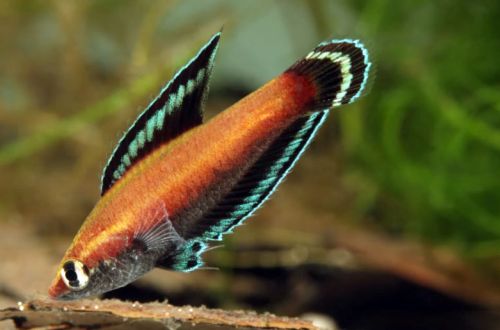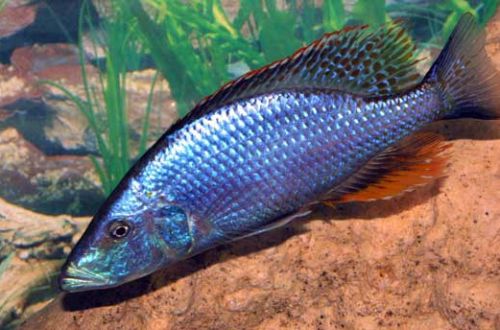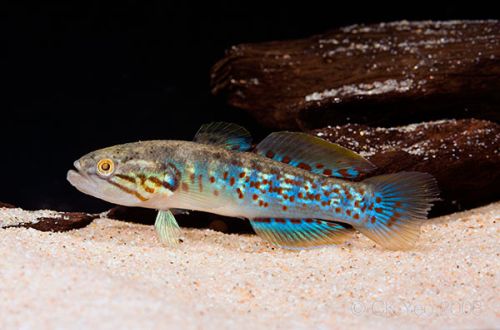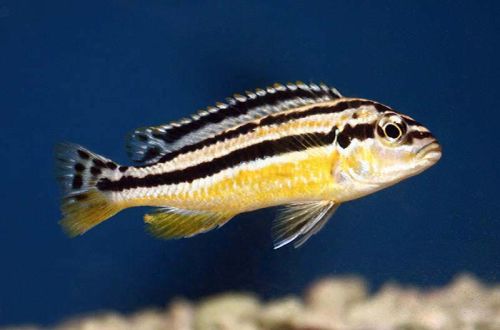
golden cichlid
The golden cichlid or Melanochromis auratus, scientific name Melanochromis auratus, belongs to the Cichlidae family. It has a magnificent golden color with large horizontal stripes. A very aggressive species has very complex intraspecific relationships, so it is very difficult to fit neighbors to this fish, even the joint maintenance of both sexes is undesirable.

This fish is one of the first cichlids to be successfully bred for the aquarium trade. However, it is not suitable for beginner aquarists precisely because of its behavior.
Requirements and conditions:
- The volume of the aquarium – from 200 liters.
- Temperature – 23-28°C
- Value pH — 7.0–8.5
- Water hardness – medium hardness (10–15 dH)
- Substrate type – sand or gravel
- Lighting – moderate
- Brackish water – allowed at a concentration of 1,0002
- Water movement – strong / moderate
- Size is about 11 cm.
- Diet – mostly plant foods
- Life expectancy is about 5 years.
Contents
Habitat
Endemic to Lake Malawi in Africa, they live in the rocky part of the lake along the southern and western extremities. Marked in the Red Book as a species of concern. A similar situation is typical for many inhabitants of the closed lake systems of the black continent. In the natural environment, they feed on hard fibrous algae that grow on rocks and stones, as well as plankton and zooplankton.
Description
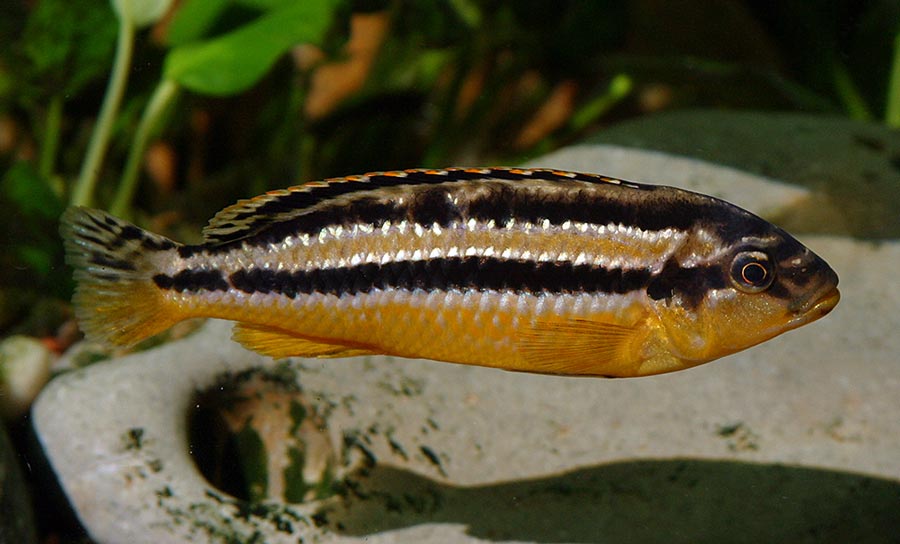
A small slender fish, has an elongated body with a rounded head. The dorsal fin is long, stretching almost along the entire back. In the oral cavity there are incisors – teeth located close to each other, designed to cut algae from the surface of rocks and stones.
The color of the floors is different with the preservation of the primary colors. The male has a dark color, the back and a horizontal stripe along the entire body are yellow. The dorsal fin is translucent with dark spots forming a line, the tail is black with yellow dots on the upper edge. The anal and ventral fins are black with a bluish edging. Females, on the other hand, are predominantly golden in color with dark horizontal stripes. The tail is light with dark specks in the upper part. The dorsal fin is body-colored with a distinct black stripe. The rest of the fins are light golden in color.
All juveniles are similar in coloration to the female, males older than 6 months, who have established their territory, gradually acquire a characteristic color. At home, when only females are kept in the aquarium, the dominant female will eventually acquire the external features of a male.
Food
Herbal supplements should make up the majority of your diet. Otherwise, the Golden Cichlid accepts all types of dry food (granules, flakes, etc.) and meat products (bloodworm, insect larvae, mosquitoes, etc.). Dried spirulina is highly recommended as a staple food, with other foods added at your discretion.
Maintenance and care
Fish produce a lot of waste, so a weekly water renewal of 25–50% is a prerequisite for successful keeping. The water has a high degree of mineralization and a high pH (alkaline water). Preservation of the required parameters can be achieved by using coral sand and/or fine aragonite gravel as a substrate, they contribute to an increase in carbonate hardness and alkalization. A similar effect is achieved when marble chips are used in the filter material of filters. The latter must have high performance in order to effectively maintain biological balance. Under such conditions, the products of decomposition of organic residues (excrement, uneaten food, pieces of plants) become especially deadly and can quickly lower the pH level, which will adversely affect the inhabitants of the aquarium.
The design will require a lot of shelters in the form of grottoes, caves, rocky embankments. They should be installed directly on the bottom of the tank and only then sprinkled with soil. Fish love to dig in the sand and if structures are installed on it, a collapse occurs. Live plants will be quickly eaten, so for a change, you can install artificial orange, red, brown colors, but not green.
Social behavior
Extremely aggressive species both in relation to other fish and to their relatives. This is especially true for males. In nature, they live in polygamous families in a specific area, where there are 6–8 females per male, any competitor will be immediately attacked. Successful keeping of the group is possible only in a large aquarium (more than 400 liters) with a sufficient number of shelters. The presence of other males is unacceptable, he will be subjected to aggression not only from the dominant, but also from females. The presence of other species is also not welcome, they are likely to be killed.
In a small tank of 150-200 liters, you can keep only one male or several females, and nothing else. In a small space with a pair of male / female, the latter will be subjected to constant attacks.
Breeding / Reproduction
Breeding is quite possible in the home aquarium. Golden cichlids are devoted parents and take care of their offspring. If you plan to breed, make sure to have a large aquarium so that each fish has a place to hide. During the spawning period, females show no less aggression than males.
The stimulus for reproduction is an increase in temperature to 26–28°C. The beginning of spawning can be determined by the color of the male, it becomes more saturated, the brightness almost doubles. Females lay about 40 eggs and immediately swallow them in their mouth, then she stimulates the male to release milk, which she inhales, thereby fertilizing the eggs in her mouth. Within 21 days, the eggs develop and fry appear. Feed brine shrimp nauplii and finely ground dry food with herbal supplements.
At first, the female guards the offspring and at the slightest danger they take refuge in her mouth. After 3 months, the juveniles reach a size of 2-3 cm, and after six months, the individual coloration of males and females appears. At this time, the males should be transferred to another tank or sold in a timely manner until the dominant male has started his “black” business.
Fish diseases
The swelling of Malawi is typical for fish native to the lake of the same name. It is associated primarily with unsuitable conditions of detention and malnutrition – a lack of plant components. The big threat lies in the old water, which has not been updated for more than a week, decay products accumulate in it, which leads to acidification, and this, in turn, disrupts the internal salt balance in the body of the fish. Read more about symptoms and treatments in the Aquarium Fish Diseases section.
Features
- Extremely aggressive look
- Requires high water quality
- Not compatible with other types



